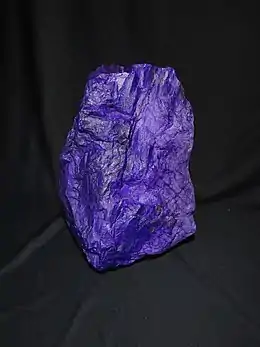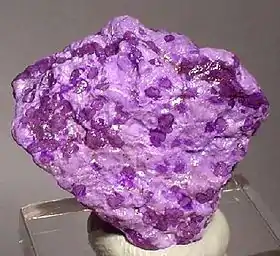| Sugilite | |
|---|---|
 16kg Manganoan Sugilite, GIA Laboratory Certified, Smithsonian Exhibition Stone, I.Kurgan Royal Azel, Hall of Gems Smithsonian Museum 1981, Wessels Mine in Northern Cape Province, South Africa | |
| General | |
| Category | Cyclosilicate |
| Formula (repeating unit) | KNa2(Fe,Mn,Al)2Li3Si12O30 |
| IMA symbol | Sug[1] |
| Strunz classification | 9.CM.05 |
| Dana classification | 63.02.01a.09 |
| Crystal system | Hexagonal |
| Crystal class | Dihexagonal dipyramidal (6/mmm) H-M symbol: (6/m 2/m 2/m) |
| Space group | P6/mcc |
| Unit cell | a = 10, c = 14 [Å]; Z = 2 |
| Identification | |
| Color | Light brownish-yellow, purple, violet, reddish violet, pale pink, colorless |
| Crystal habit | Prismatic crystals, typically granular to massive |
| Cleavage | Poor on {0001} |
| Mohs scale hardness | 6–6+1⁄2 |
| Luster | Vitreous |
| Streak | White |
| Diaphaneity | Transparent to translucent |
| Specific gravity | 2.74 |
| Optical properties | Uniaxial (−) |
| Refractive index | nω = 1.610 nε = 1.607 |
| Birefringence | δ = 0.003 |
| Pleochroism | Weak |
| References | [2][3][4] |
Sugilite (/ˈsuːɡəlaɪt, -dʒi-/ SOO-gə-lyte, -jee-)[2][3] is a relatively rare pink to purple cyclosilicate mineral with the complex chemical formula KNa2(Fe, Mn, Al)2Li3Si12O30. Sugilite crystallizes in the hexagonal system with prismatic crystals. The crystals are rarely found and the form is usually massive. It has a Mohs hardness of 5.5–6.5 and a specific gravity of 2.75–2.80. It is mostly translucent. Sugilite was first described in 1944 by the Japanese petrologist Ken-ichi Sugi (1901–1948) for an occurrence on Iwagi Islet, Japan, where it is found in an aegirine syenite intrusive stock. It is found in a similar environment at Mont Saint-Hilaire, Quebec, Canada. In the Wessels mine in Northern Cape Province of South Africa, sugilite is mined from a strata-bound manganese deposit. It is also reported from Liguria and Tuscany, Italy; New South Wales, Australia and Madhya Pradesh, India.[4]
Sugilite is commonly pronounced with a soft "g", as in "ginger". However, as with most minerals, its pronunciation is intended to be the same as the person it is named after; in this case, the Japanese name Sugi has a hard "g", as in "geese".[5]
The mineral is also referred to as lavulite, luvulite, and royal azel by gem and mineral collectors.[3]


See also
References
- ↑ Warr, L.N. (2021). "IMA–CNMNC approved mineral symbols". Mineralogical Magazine. 85 (3): 291–320. Bibcode:2021MinM...85..291W. doi:10.1180/mgm.2021.43. S2CID 235729616.
- 1 2 Barthelmy, David (2014). "Sugilite Mineral Data". Webmineral.com. Retrieved 22 July 2022.
- 1 2 3 Sugilite, Mindat.org
- 1 2 Anthony, John W.; Bideaux, Richard A.; Bladh, Kenneth W.; Nichols, Monte C. (2005). "Sugilite" (PDF). Handbook of Mineralogy. Mineral Data Publishing. Retrieved 14 March 2022.
- ↑ "OpenLearn Live: 8th September 2015 - Meet The Minerals". OpenLearn. The Open University. Retrieved 20 January 2016.